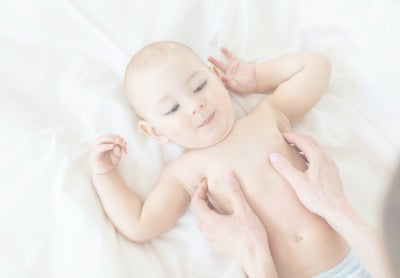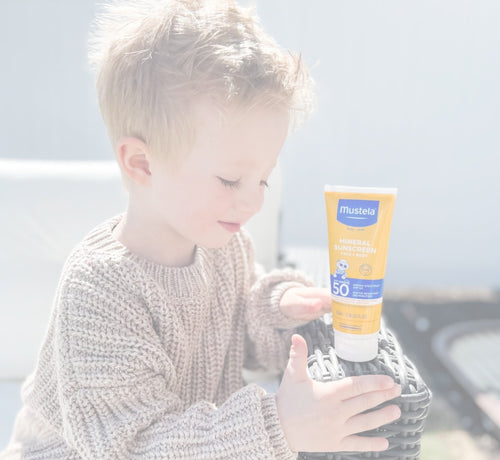Noticing that your baby has a rash can be alarming. The rash may be causing your little one discomfort. Worse still, you might not know where it came from. While there are many skin conditions that little ones often experience, baby heat rash is one of the most common.
In fact, it may even be the first type of rash to affect your child.
In this article, the baby experts at Mustela will explain everything you need to know about baby heat rash. We’ll tell you exactly what it is and how to identify it, as well as how to prevent and treat it.
Follow the easy tips we provide in this post and your baby’s skin will be back to normal in no time.
Table Of Contents
- What Is Baby Heat Rash?
- How Can You Tell If Your Baby Has Heat Rash?
- How To Treat Baby Heat Rash
- When Should You Call Your Doctor?
- Frequently Asked Questions

What Is Baby Heat Rash?
Baby heat rash, also called prickly heat or miliaria, is not a contagious skin rash. As the name suggests, heat rash is a skin condition that develops when your baby’s skin gets too hot. More specifically, heat rash is caused when sweat gets stuck in your baby’s pores.
When your baby’s body becomes hot, their skin begins to produce sweat (which is a cooling mechanism for the human body). Normally, drops of sweat would simply be released through pores. However, babies have tiny pores that can easily become clogged.
Heat rash is the result of sweat getting caught in those small pores as it tries to reach the surface of your little one’s skin.
Summer is the most common season for heat rash because we all sweat a bit more during the hot summer months. Humid climates can also contribute to heat rash. But this skin condition doesn’t only occur when the temperature is high!
It can also form when it’s cold, especially if your baby is wearing many layers of clothing. Remember to de-layer when you go indoors.
Fortunately, heat rash isn’t a serious condition. It’s perfectly normal for babies to get heat rash, and with proper treatment, it usually goes away after a few days.
How Can You Tell If Your Baby Has Heat Rash?
Babies have soft, delicate skin. This means that their skin is more sensitive and prone to conditions like dryness, eczema, and rashes. Baby heat rash can be identified by the following symptoms:
- Patches of red, itchy skin
- Tiny bumps or pimples
- Slight inflammation or puffiness
- Irritation and discomfort
If you’ve noticed these telltale signs on your baby’s skin, they may be suffering from heat rash.
Keep an extra close eye on your baby’s chest, neck, diaper area, or armpits.
Your baby is more likely to develop heat rash in these places because they are the areas that usually produce the most sweat. Clothing also tends to fit tightly around those parts of their body.
So how can you tell baby heat rash apart from other skin conditions, like eczema or cradle cap?

Eczema Versus Baby Heat Rash
Eczema, also known as atopic dermatitis, typically shows up as red or yellow swollen patches of skin. While it is commonly found on babies’ faces, it can flare up on any part of the body. Your baby’s skin will be itchy, and the itchiness might even make it difficult for them to sleep well.
As opposed to run-of-the-mill dry skin, the rough, dry patches of eczema don’t go away when you apply lotion (although the right eczema skin care can help!).
Eczema will normally cause flaking and feel rough to the touch. Heat rash, on the other hand, causes small bumps or tiny blisters to form on the surface of your baby’s skin.
Read more about baby eczema here.
Cradle Cap Versus Baby Heat Rash
Cradle cap also causes red, flaky skin, but this condition most often forms on your baby’s head and forehead. While a mild case looks like red, flaky skin, a more extreme case of cradle cap produces raised patches of crusty, oily skin.
Although it can be unsightly, cradle cap is harmless and not contagious. You’ll simply want to keep an eye on things, resist the urge to pick at the flakes, and use cradle cap-specific skincare products, such as Cradle Cap Cream and Foam Shampoo for Newborns.
Click here to read about how to care for cradle cap.

With that information under your belt, if it’s clear that your little one has baby heat rash, here’s what you need to know to care for your baby’s skin.
Let’s start with prevention so you know how to fend it off. Then, we’ll discuss how to treat heat rash if your little one does develop it.
How To Prevent Baby Heat Rash
If your baby hasn’t yet developed a heat rash, consider yourself lucky! It’s a common ailment that most babies suffer from at one point or another. But this doesn’t mean baby heat rash is inevitable! There are several simple steps you can take to prevent it.
Keep Your Baby Cool
If your baby is nice and cool, their body doesn’t need to sweat. No sweating means no heat rash! If your baby’s cheeks become flushed, it’s probably a sign that they’re a bit too hot. Whenever you notice rosy red cheeks, move your baby to a cooler area.
Another option when you notice rosy red cheeks is to run cool water over your little one’s skin. The cool water will rinse away the sweat and body oil. Next, you can apply a cool, wet washcloth to lower your baby's body temperature.
Keeping your baby cool also means checking your baby’s body temperature frequently. Babies tend to get hot quickly, much faster than adults do. So keeping an eye on your baby when you’re in a hot environment, such as outside, will help prevent a heat rash from developing.
And, mom, you know your little one best. If you notice your baby starting to get uncomfortable and fussy while outside — or even in a warm house — this is a sign that your baby may be too hot.
Don’t Spend Too Much Time In The Sun

While there’s nothing wrong with enjoying some sunshine with your little bundle of joy, don’t spend too long in the sun. The heat the sunlight brings can lead to baby heat rash.
Heat rash isn’t the only concern when it comes to fun in the sun. Too much direct sunlight can cause sunburn and poses dangers to your baby’s sensitive skin. Caution is the name of the game!
Avoid direct sunlight and peak sun hours (between 10:00 a.m, and 4:00 p.m.), dress your baby in protective clothing — like a sun hat and loose clothing — and apply baby-safe sunscreen.
We recommend a mineral sunscreen that protects your baby’s delicate skin without the use of questionable ingredients often found in chemical sunscreen. Click here to read about the differences between these two types of sunscreen.
Our SPF 50 Mineral Sunscreen Lotion offers safe and effective sun protection for babies as well as adults (it’s perfect for adults with sensitive skin!).
Made with 93% naturally derived ingredients including coconut oil, macadamia oil, and vitamin E, this sunscreen hydrates your baby’s skin while warding off the sun’s rays.
If you prefer spray-on mineral sunscreen, check out our SPF 30 Mineral Sunscreen Spray. Or, pack a travel-friendly SPF 50 Mineral Sunscreen Stick for compact sun protection!
No matter which Mustela sunscreen you choose, rest assured that it’s approved by the National Eczema Association (NEA) and free of harmful ingredients.
Keep Your Baby’s Skin Dry

Moisturized skin is generally a good thing, but too much moisture can irritate your baby’s skin. This is especially true when heat is added to the mix.
To prevent heat rash, make sure you are using a moisturizer formulated for your baby’s skin type so no excess moisture remains. And always make sure your baby is dry before dressing them.
Remember to pay particular attention to your baby’s skin folds when drying your little one off after a bath. We’re talking about areas such as the neck, arms, legs, and diaper area. You’ll want to make sure these specific areas are completely dry.
When changing your baby’s diaper, allow their bum to dry completely before putting on a new diaper. Use a diaper cream designed to protect and soothe your baby’s bottom.
Our Diaper Rash Cream 1 2 3 is a three-in-one product clinically proven to soothe your baby’s diaper area and relieve irritation and redness from the first use.
This hypoallergenic cream is accepted by the National Eczema Association and infused with zinc oxide to create a comfortable, protective barrier.
If you prefer an EWG Verified diaper cream option, opt for Diaper Cream with Olive Oil and Aloe. It’s made with 99.7% naturally derived ingredients, including aloe vera, sunflower oil, and olive oil sourced from family-owned groves in the South of France.
You can rest assured that this baby product is good for your baby and the earth, too. The packaging is made from sustainably sourced sugar cane, and we’ve gotten rid of secondary cartons. That’s a win-win all the way around.

Dress Your Baby In Layers
Babies are a bit fickle when it comes to temperatures. They get cold easily, but they can also get too hot very quickly.
The easiest solution is to dress your little one in layers. Think: a onesie as a base layer, then a long-sleeved shirt, a cardigan, and so on. Whenever your baby seems hot, simply remove a layer. When you notice that your baby is feeling cold again, just add another layer.
Avoid Dressing Your Baby In Tight Clothing
Tight-fitting clothing won’t allow your baby’s skin to breathe and can actually lead to heat rash. Moisture can easily lock into your baby’s skin when they wear tight clothes, creating the perfect environment for a heat rash to develop.
Dress your little one in loose clothing to prevent heat rash from occurring.
How To Treat Baby Heat Rash
As we mentioned earlier, heat rash is easy to treat and normally goes away in two to three days, if not sooner. Here are the best ways to treat your baby’s heat rash.
Let Your Baby’s Skin Breathe And Dry Out
It’s extremely important to keep the areas affected by heat rash completely dry. This is essential to get rid of your baby’s heat rash.
Why is keeping your little one’s skin dry so important? As we explained earlier in the post, heat rash is caused by sweat clogging your baby’s pores.
Letting your little one’s skin breathe is an excellent way to clear up heat rash because it dries their skin. Allow your baby to be naked (or just in a diaper) for as much time as possible until the rash goes away.
Adjust The Temperature In Your Home
One easy way to treat heat rash is to lower the temperature in your home. This will help keep your baby’s skin cool and dry, which will help the rash to clear up on its own.
It’s particularly important to make sure your baby isn’t too hot while they sleep. Adjust the thermostat or try turning a fan on low if your baby’s room tends to be too warm at night.
Apply Skin Care Products Made Especially For Babies

Using the right cream can work wonders when treating your baby’s heat rash. Just be sure to choose skin care products that are safe to use with infants and toddlers.
Stelatopia Emollient Balm is an excellent product to use, as it will soothe your baby’s skin while also helping the rash to heal.
This daily balm is designed for extremely dry and eczema-prone baby skin, meaning it’s oh-so-gentle and works to replenish and protect your baby’s sensitive skin, leaving it healthy and itch-free.
The rich, occlusive texture penetrates the skin quickly and is ideal for nighttime use. In addition to natural ingredients, such as sunflower oil distillate and carnauba wax, this product contains avocado perseose, a patented nutrient that strengthens babies’ skin barrier.
This unique ingredient protects the cell capital that is found in the underdeveloped skin of little ones and is made from zero-waste organic avocados grown in the heart of Peru. Read more about this wonderful ingredient here.
Use Mild Cleansers Rather Than Soaps
Most soaps are simply too harsh for a baby’s delicate skin and should be avoided whenever possible. Additionally, a few specific ingredients are particular no-nos for baby skin care.
Let’s take a look.
Phenoxyethanol
Phenoxyethanol is a synthetically produced chemical that’s used as a preservative in skincare products. While you don’t want bacteria growing in your baby’s bath gel, phenoxyethanol isn’t the best way to keep skincare products shelf-stable.
It can irritate your baby’s skin and cause a host of other more serious and unwanted health problems. Read all about phenoxyethanol here.
Parabens
Another preservative, parabens can be found in food and skincare products. But this ingredient can cause hormone disruption which is bad news for both you and your baby.
Phthalates
Phthalates are plasticizers, used to make plastics more flexible. If that’s the case, you might be wondering what they’re doing in your baby’s lotion. This ingredient can also be used to improve the scent of skincare products.
The dark side of phthalates is that they may be linked to hormone disruption, neurodevelopmental disorders, asthma, and allergies. We think it’s safer to stay away from phthalates entirely.
Sulfates
This ingredient might sound familiar to you since sulfate-free shampoo is becoming more and more popular. They’re often used in shampoos and soaps because they create the foamy lather that makes us feel squeaky clean.
But they can be drying and irritating to skin, especially your baby’s extra-delicate skin!

Instead of using products with these harsh chemical ingredients, choose gentle cleansers with natural ingredients to bathe your baby as part of their daily hygiene routine.
This is a great way to treat heat rash and will help keep your baby’s skin healthy. We offer several baby-friendly cleansers, like our Soothing Cleansing Gel and our Gentle Cleansing Gel.
EWG Verified, fragrance-free, and hypoallergenic, Soothing Cleansing Gel safely and effectively cleans your baby's hair and body while also working to relieve feelings of tingling and tightness. The biodegradable formula is specifically designed for babies with rashy or reactive skin.
Instead of chemical ingredients such as parabens, phthalates, and phenoxyethanol, this cleansing gel is composed of 98% natural ingredients including avocado perseose and schizandra.
Meanwhile, our Gentle Cleansing Gel is perfect for babies with normal skin as it cleans thoroughly without stripping your little one’s skin and scalp of their natural, healthy oils.
This cleansing gel is tested under pediatric and dermatological control and, like all Mustela products, is free of parabens, phthalates, and phenoxyethanol.
Be Gentle With Your Baby’s Skin
This may seem obvious, but it’s worth repeating: always be gentle with your little one’s skin! Be careful not to rub or scratch your baby’s skin when dressing them. You can even let your little one air-dry after a bath to cool off if you have the time.
If you’re not air-drying after bathtime, pat (rather than rub) your baby dry with a soft towel and only use gentle skincare products that are specially designed for a baby’s delicate skin.
Dress Your Baby In Loose Clothing

As we mentioned earlier, tight-fitting clothing may create an environment for a heat rash to develop. So if your little one already has a heat rash, dress them in loose-fitting clothing to help treat it and soothe their skin.
Loose-fitting clothing won’t rub against your baby’s skin and is, therefore, less likely to further irritate heat rash. Tight clothing may inflame the rash by rubbing against the affected area or by making your baby sweat even more.
Try to dress your baby in loose clothing made from soft, breathable fabrics.
If you’ve never given a second thought to what your baby wears and how it may affect their skin, it’s worth taking stock of your baby’s clothes and pajamas.
The proper clothing is, of course, especially important for babies with eczema-prone skin, but it can make a difference even if your baby doesn’t deal with eczema.
Soft, natural, breathable fabrics are ideal, and if you want to take it a step further at bedtime, dress your little one in Stelatopia Skin Soothing Pajamas.

These 100% cotton pajamas use microcapsule technology to deliver skin-soothing moisture to the skin throughout the night. Each microcapsule contains five natural ingredients: avocado oil, sunflower oil distillate, squalane, ceramides, and vitamin E.
These ingredients are activated when they come in contact with the skin and help keep it soothed, comfortable, and moisturized all night long. Plus, the OEKO-TEK® certified cotton is free of any allergens or potentially harmful substances.
Sweet dreams, little one!
Give Your Baby Plenty Of Fluids
While your little one is fighting off a heat rash, they may be dehydrated. There’s very likely a lot of moisture locked in their skin and the rash. Plus, their body is working overtime to unclog their pores and eliminate the rash!
Give your baby plenty of fluids so that their body has the hydration it needs until the heat rash is gone.
If your baby is still on only breastmilk or formula, hydrating simply means ensuring that your little one is nursing or taking a bottle frequently.
With all of that breastfeeding, be sure to care for yourself as well with Nursing Comfort Balm. A soothing and restorative nipple cream, this lanolin-free formula eases discomfort and helps replenish your skin during and after breastfeeding.
The vegan, fragrance-free, and dye-free formula is safe for use throughout pregnancy, too!
All of that said, if you have concerns that your baby is truly dehydrated (fewer wet diapers, no tears, fussiness, wrinkly skin, sunken eyes, etc.), call your pediatrician as soon as possible since dehydration can be a serious condition.
Limit The Time Your Baby Spends Tightly Wrapped Up
Although babies love the feeling of being swaddled, you should skip this comforting activity while fighting your baby’s heat rash. It’s also best to limit the time your baby spends in carriers, strollers, and car seats.
These places can inflame heat rash, so it’s best to avoid them until your little one’s skin is back to normal.
Baby expert tip: Keep your baby’s fingernails trimmed. This way, if a heat rash appears, your little one won’t be able to scratch the area. Also, if your baby already has a heat rash, put little socks or mittens on their hands at night to prevent scratching while sleeping.
When Should You Call Your Doctor?
Heat rash is very rarely a serious condition. Usually, it resolves on its own, especially if you’re putting into practice the tips for treating and preventing heat rash already mentioned in this article. But be on the lookout for the following:
- Fever
- Chills
- Increased pain
- Pus draining from the bumps
- Appetite loss
- Rash lasting longer than three or four days
If you’re noticing any of these symptoms along with a general case of heat rash, reach out to your little one’s pediatrician for further assistance.
Beating Baby Heat Rash

Baby heat rash is never fun, but it’s very common and easily treatable. Keeping your baby cool, not spending too much time in the sun, and keeping your baby’s skin dry are a few ways to prevent your baby from getting heat rash in the first place.
To treat baby heat rash, let your baby’s skin breathe and dry out, adjust the temperature in your home, apply Stelatopia+ Lipid-Replenishing Cream, and use mild cleansers, such as Mustela Soothing Cleansing Gel.
Remember to be gentle with their skin and dress your little one in loose clothing if a heat rash develops. And don’t forget to keep your baby hydrated.
Follow the simple tips we’ve outlined above, and your baby’s skin will be soft and smooth again in just a few days!
Frequently Asked Questions
1) Does Breast Milk Help Heat Rash?
While scientific studies have shown promising results in using breast milk to treat some skin conditions, such as eczema and diaper rashes, research on treating a heat rash with it has yet to be done.
But, even though the scientific community hasn’t studied this connection yet, some parents have anecdotal reports of breast milk helping reduce the severity of a heat rash.
If you’d like to try it, your milk won’t harm your baby’s skin. Just remember that it might not give you the results you were hoping for, and you may need to try something else.
2) Is Heat Rash Painful For Babies?
Heat rash can be irritating for your baby. Their skin might feel itchy or a bit painful. To help reduce their pain, use a cream specially designed for babies, such as the Stelatopia Emollient Balm from Mustela.
If your baby is in a lot of pain from a heat rash, it’s a good idea to seek medical care. They can help rule out any other conditions and provide individualized treatment options.
3) Will My Baby’s Heat Rash Go Away On Its Own?
Left untreated, your baby’s heat rash should disappear within a few days. If it doesn’t, you can use the treatment methods listed above to help improve your baby’s skin.
After you begin treatment, you should notice the rash fading fairly quickly. But, if it’s been a week and you still don’t see any improvements, make an appointment with your baby’s healthcare provider.












